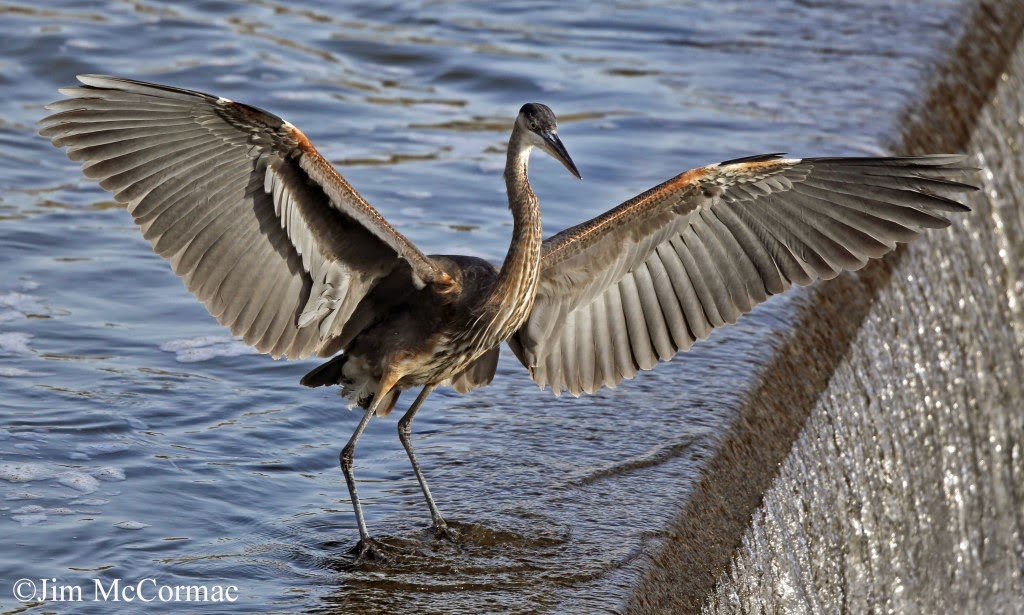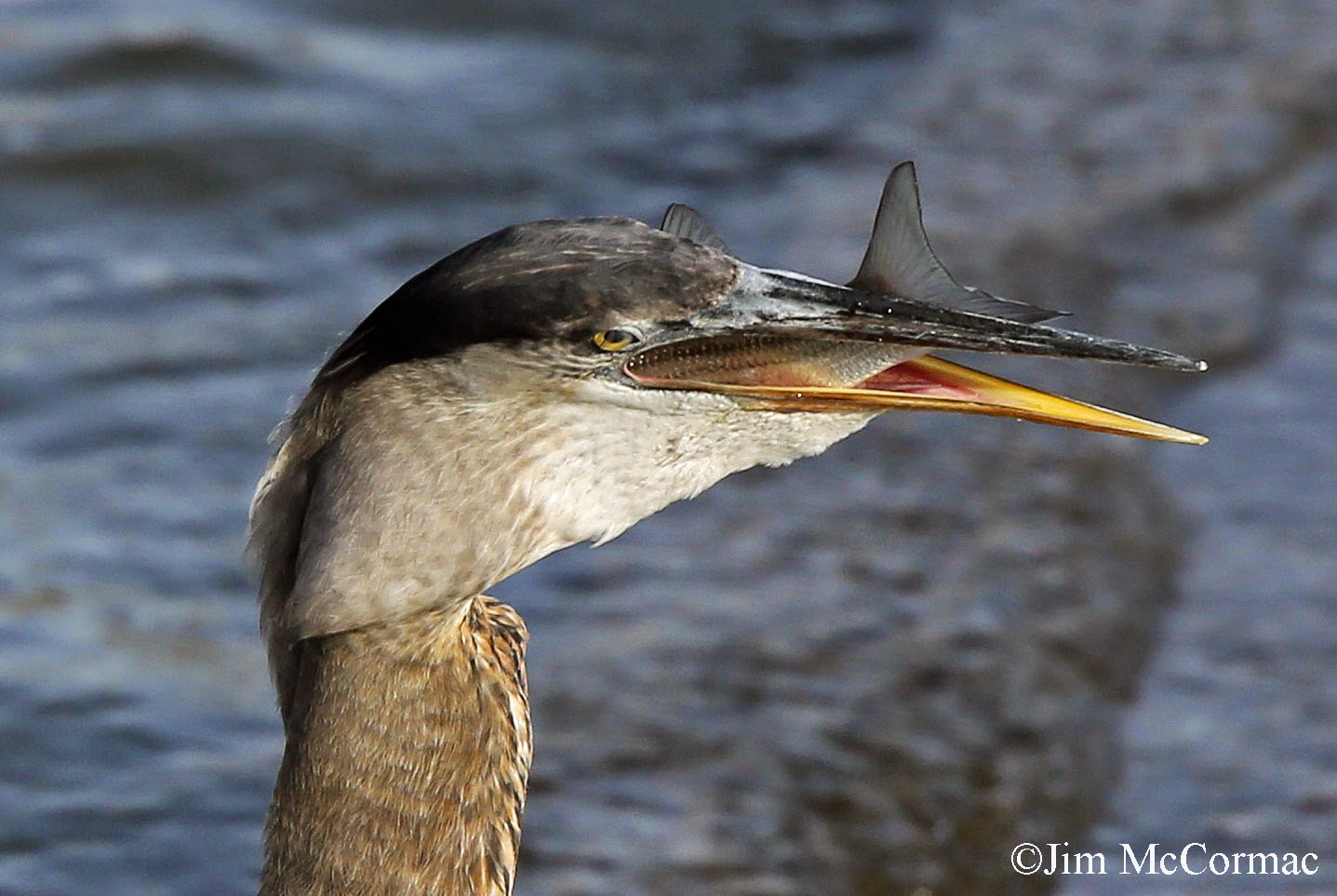The tail waters of Hoover Reservoir in northern Franklin County. The dam impounds a large reservoir that extends north into Delaware County, and when it freezes, the open waters below the dam teem with birds. A brief stop here last Saturday produced some interesting observations, but none bested the hungry heron that follows.
As the torrential outflow from the dam always keeps some water open, hardy Great Blue Herons overwinter here. There are usually at least a half-dozen or so at any time. Lots of fish get sucked through the dam's tunnels, and are expelled relatively unharmed in the basin below the dam. They make for easy pickings for the herons, and the bird above is stalking fish.
It didn't take long for the heron to spot prey, and quicker than you might think possible, he was out in deep water and instantly bagged a good one.That's a hefty white bass, Morone chrysops, in its bill, and it hardly seems possible that the bird could swallow that thing.
Apparently the heron wanted to deal with its piscine prey on firmer ground, so it swam ducklike back to the cement skirt of the catch basin. Only to be greeted by an aggressive heron that seemed to be making overtures towards its hard won catch.
A few shakes of those massive wings, probably accompanied by some Neanderthal grunts, and the would-be aggressor was sent packing.
Now the fun begins. The heron deftly shakes and quivers the fish into proper swallowing position, which is headfirst. The fish is very much alive, and probably had other plans for its day; plans that didn't include being swallowed alive by some gargantuan, primitive sushi-spearer. Note the bass's dorsal fin, which is stiffly extended and webbed with hard sharp spines. The fin folds backward - if the heron didn't swallow the fish headfirst, it would have no chance of gagging the thing down. The dorsal spines would tear into its throat, probably causing damage and certainly impeding progress.
It didn't take long for the skilled fisherbird to suck the bass into its gullet. The outline of the fish's head and half its body is clearly seen silhouetted through the bird's throat. What a way to go. If you're a white bass, don't go getting yourself sucked through Hoover Dam and into the tail waters. As rough and unwanted a trip as that would be, this fate is worse.
No escape for the bass now. It hardly seems possible that a heron could swallow a fish that large, but I've seen them successfully put down significantly larger fish.
An extended neck is the only evidence that the fish once was.
A happy little burp, and game over: heron 1 - fish - 0. After being dissolved by caustic gastric acids in the heron's digestive tract, what's left of the bass will later be projectile-sprayed from the bird's posterior in a showy display of fecal fluming.
Ah, Nature. Brutal as it may be, you gotta love it.
As the torrential outflow from the dam always keeps some water open, hardy Great Blue Herons overwinter here. There are usually at least a half-dozen or so at any time. Lots of fish get sucked through the dam's tunnels, and are expelled relatively unharmed in the basin below the dam. They make for easy pickings for the herons, and the bird above is stalking fish.
It didn't take long for the heron to spot prey, and quicker than you might think possible, he was out in deep water and instantly bagged a good one.That's a hefty white bass, Morone chrysops, in its bill, and it hardly seems possible that the bird could swallow that thing.
Apparently the heron wanted to deal with its piscine prey on firmer ground, so it swam ducklike back to the cement skirt of the catch basin. Only to be greeted by an aggressive heron that seemed to be making overtures towards its hard won catch.
A few shakes of those massive wings, probably accompanied by some Neanderthal grunts, and the would-be aggressor was sent packing.
Now the fun begins. The heron deftly shakes and quivers the fish into proper swallowing position, which is headfirst. The fish is very much alive, and probably had other plans for its day; plans that didn't include being swallowed alive by some gargantuan, primitive sushi-spearer. Note the bass's dorsal fin, which is stiffly extended and webbed with hard sharp spines. The fin folds backward - if the heron didn't swallow the fish headfirst, it would have no chance of gagging the thing down. The dorsal spines would tear into its throat, probably causing damage and certainly impeding progress.
It didn't take long for the skilled fisherbird to suck the bass into its gullet. The outline of the fish's head and half its body is clearly seen silhouetted through the bird's throat. What a way to go. If you're a white bass, don't go getting yourself sucked through Hoover Dam and into the tail waters. As rough and unwanted a trip as that would be, this fate is worse.
No escape for the bass now. It hardly seems possible that a heron could swallow a fish that large, but I've seen them successfully put down significantly larger fish.
An extended neck is the only evidence that the fish once was.
A happy little burp, and game over: heron 1 - fish - 0. After being dissolved by caustic gastric acids in the heron's digestive tract, what's left of the bass will later be projectile-sprayed from the bird's posterior in a showy display of fecal fluming.
Ah, Nature. Brutal as it may be, you gotta love it.
.jpg)
.jpg)
.jpg)
.jpg)
.jpg)
.jpg)
.jpg)
.jpg)
.jpg)
.jpg)